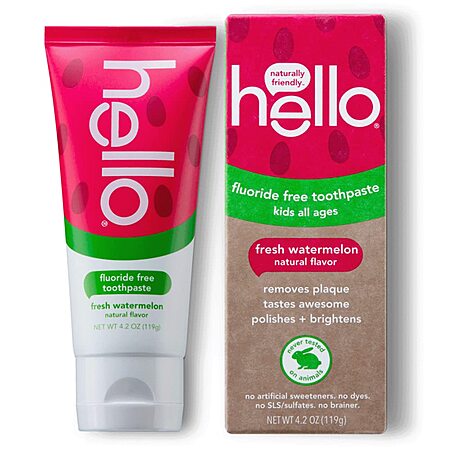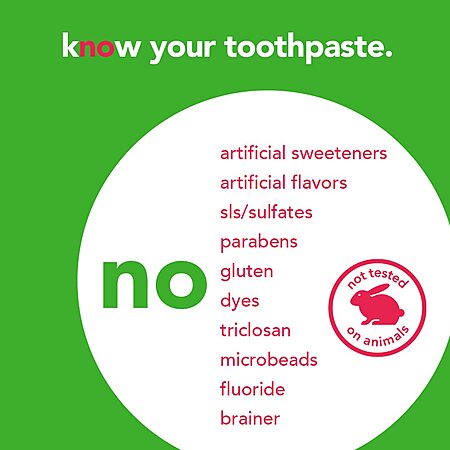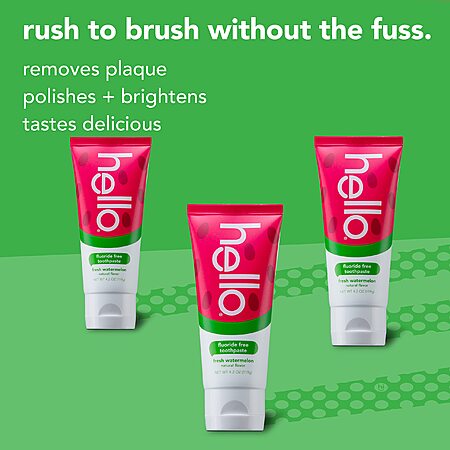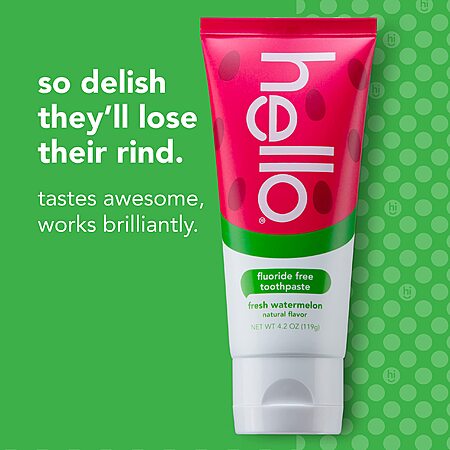expiredStrongWeather642 | Staff posted Nov 24, 2023 10:31 AM
Item 1 of 4
Item 1 of 4
expiredStrongWeather642 | Staff posted Nov 24, 2023 10:31 AM
4.2-Oz hello Kids Fluoride and SLS Free Vegan Toothpaste (Watermelon) $2.96 w/ S&S + Free Shipping w/ Prime or on $35+
$2.96
$5.22
43% offAmazon
Visit AmazonGood Deal
Bad Deal
Save
Share








Leave a Comment
17 Comments
Sign up for a Slickdeals account to remove this ad.
hello Unicorn Sparkle Kids Fluoride Toothpaste, Natural Bubble Gum Flavor, ADA Approved, Ages 2+, No Artificial Sweeteners, No SLS, Gluten Free, Vegan, Pack of 3, 4.2 oz Tubes https://a.co/d/demZ4KS
hello Unicorn Sparkle Kids Fluoride Toothpaste, Natural Bubble Gum Flavor, ADA Approved, Ages 2+, No Artificial Sweeteners, No SLS, Gluten Free, Vegan, Pack of 3, 4.2 oz Tubes https://a.co/d/demZ4KS
Thanks kupop2 for the heads up. Added to the deal.
Sign up for a Slickdeals account to remove this ad.
Since most water supplies have fluoride added, it is double dosing and rates of dental fluorosis have gone up drastically.
" The prevalence rate of dental fluorosis was highest, 41%, in adolescents and lowest, 8.7%, in those age 40–49. A more recent analysis of NHANES data in 2001–2002 and 2011–2012 found that rates of dental fluorosis (from very mild to severe) increased during this 10-year period, from 29.7% to 61.3% [43]."
Since most water supplies have fluoride added, it is double dosing and rates of dental fluorosis have gone up drastically.
" The prevalence rate of dental fluorosis was highest, 41%, in adolescents and lowest, 8.7%, in those age 40–49. A more recent analysis of NHANES data in 2001–2002 and 2011–2012 found that rates of dental fluorosis (from very mild to severe) increased during this 10-year period, from 29.7% to 61.3% [43]."
For those who haven't made up their mind about Floride in kids toothpaste, fluorosis is the increased white areas some people have on their teeth if you look really close. Don't think most people care about that as it's not cosmetic unless severe. Fluorosis is definitely preferable to dental decay. As a side note, dental decay is associated with other inflammatory conditions such as heart disease.
For those who haven't made up their mind about Floride in kids toothpaste, fluorosis is the increased white areas some people have on their teeth if you look really close. Don't think most people care about that as it's not cosmetic unless severe. Fluorosis is definitely preferable to dental decay. As a side note, dental decay is associated with other inflammatory conditions such as heart disease.
Not taken out of context at all, maybe just going against what your thoughts on the topic are, but not out of context. Might be worth doing more research before trying to educate others on the topic.
It is under the "Health Risks from Excessive Fluoride" section.
Clearly the recommended daily intake limits are not being followed when considering all sources of fluoride, such as water, toothpaste, floss, mouthwash, foods, dental treatments, etc. as shown by the increased rate of fluorisis seen.
Fluorisis is also not only white areas as you put it, but can also be brown, or pitting in the enamel. More importantly, it is simply an easily seen indicator that fluoride intake has been too high during development, while other side effects of excessive fluoride intake are not as easily seen.
Here is a very simple extract,
"Daily tolerable upper intake limit for fluoride for healthy individuals:
1–3 years1.3 mg
4–8 years 2.2 mg
"According to the EPA, typical daily fluoride intakes in the United States from foods and beverages (including fluoridated drinking water) are 1.2 to 1.6 mg for infants and toddlers younger than 4 years, 2.0 to 2.2 mg for children age 4–11 years,"
So with fluoride added into the water supply, children are already at or above the upper tolerable limit. Add in fluoride in the toothpaste, and they are now 10-20% over the limit each day. Fluoride treatments and other increased exposure instances, all clearly lead to the increased fluorisis rates, along with the other potential unseen side effects.
" Estimated typical amounts of fluoride ingested daily from toothpaste are 0.1 mg to 0.25 mg for infants and children age 0 to 5 years"
"Most people in the United States consume adequate amounts of fluoride through foods containing naturally occurring fluoride, fluoridated tap water, and food products made with fluoridated tap water. According to the EPA, typical daily fluoride intakes in the United States from foods and beverages (including fluoridated drinking water) are 1.2 to 1.6 mg for infants and toddlers younger than 4 years, 2.0 to 2.2 mg for children age 4–11 years, 2.4 mg for those age 11–14 years, and 2.9 mg for adults [10]."
" Estimated typical amounts of fluoride ingested daily from toothpaste are 0.1 mg to 0.25 mg for infants and children age 0 to 5 years, 0.2 to 0.3 mg for children age 6–12 years, and 0.1 mg for adults [3]."
Additionally, fluoride does not completely prevent dental decay, and inflammation and bacteria that lead to heart conditions are not controlled by fluoride in toothpaste, so your comparison and conclusion that fluoridated toothpaste is necessary or worth the risk is not really valid.
Not taken out of context at all, maybe just going against what your thoughts on the topic are, but not out of context. Might be worth doing more research before trying to educate others on the topic.
It is under the "Health Risks from Excessive Fluoride" section.
Clearly the recommended daily intake limits are not being followed when considering all sources of fluoride, such as water, toothpaste, floss, mouthwash, foods, dental treatments, etc. as shown by the increased rate of fluorisis seen.
Fluorisis is also not only white areas as you put it, but can also be brown, or pitting in the enamel. More importantly, it is simply an easily seen indicator that fluoride intake has been too high during development, while other side effects of excessive fluoride intake are not as easily seen.
Here is a very simple extract,
"Daily tolerable upper intake limit for fluoride for healthy individuals:
1–3 years1.3 mg
4–8 years 2.2 mg
"According to the EPA, typical daily fluoride intakes in the United States from foods and beverages (including fluoridated drinking water) are 1.2 to 1.6 mg for infants and toddlers younger than 4 years, 2.0 to 2.2 mg for children age 4–11 years,"
So with fluoride added into the water supply, children are already at or above the upper tolerable limit. Add in fluoride in the toothpaste, and they are now 10-20% over the limit each day. Fluoride treatments and other increased exposure instances, all clearly lead to the increased fluorisis rates, along with the other potential unseen side effects.
" Estimated typical amounts of fluoride ingested daily from toothpaste are 0.1 mg to 0.25 mg for infants and children age 0 to 5 years"
"Most people in the United States consume adequate amounts of fluoride through foods containing naturally occurring fluoride, fluoridated tap water, and food products made with fluoridated tap water. According to the EPA, typical daily fluoride intakes in the United States from foods and beverages (including fluoridated drinking water) are 1.2 to 1.6 mg for infants and toddlers younger than 4 years, 2.0 to 2.2 mg for children age 4–11 years, 2.4 mg for those age 11–14 years, and 2.9 mg for adults [10]."
" Estimated typical amounts of fluoride ingested daily from toothpaste are 0.1 mg to 0.25 mg for infants and children age 0 to 5 years, 0.2 to 0.3 mg for children age 6–12 years, and 0.1 mg for adults [3]."
Additionally, fluoride does not completely prevent dental decay, and inflammation and bacteria that lead to heart conditions are not controlled by fluoride in toothpaste, so your comparison and conclusion that fluoridated toothpaste is necessary or worth the risk is not really valid.
Not trying to change your mind, but want others to base their opinions on all the data. And the reason I'm not trying to change your opinion is because as a medical provider I have no doubt that you're very diligent with your kids dental health and that their teeth are in great shape. Unfortunately many parents are not as diligent and for these kids every bit helps, including the use of Floride to harden their enamel to help prevent dental carries.
Sign up for a Slickdeals account to remove this ad.
Not trying to change your mind, but want others to base their opinions on all the data. And the reason I'm not trying to change your opinion is because as a medical provider I have no doubt that you're very diligent with your kids dental health and that their teeth are in great shape. Unfortunately many parents are not as diligent and for these kids every bit helps, including the use of Floride to harden their enamel to help prevent dental carries.
Since you keep mentioning vitamin d, imagine if this deal was about a children's vitamin d supplement. If, hypothetically speaking, children were already getting 100-120% the upper tolerable limit of daily vitamin d from other sources, would sharing data about risks from excessive vitamin d intake, along with evidence of current intake levels, be "cherry picking data" as you put it?
As a mechanical engineer and father, I follow what data shows to be best for the health of my family. If the data changed, and there was no fluoride in any other sources, then fluoride in toothpaste could make sense. But currently that is not the case, and fluoride intake from other sources is already excessive.
Leave a Comment